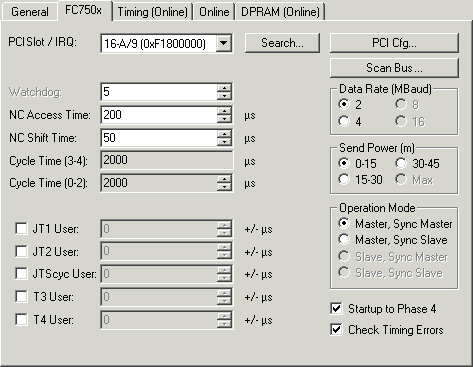The FC750x tab
PCI Slot / IRQ
Shows in which logical PCI slot the card was detected and which IRQ is assigned to it. The IRQ is unused.
Search...
Searches for all connected FC750x channels. Select those required. In the case of an FC7502 both channels A and B appear. These behave in logical terms like two FC7501 cards.
PCI-Cfg...
In which the address of the FC750x is set in the lower memory area (below 1 MB) of the PC.
Scan the bus...
The Sercos ring is scanned here, and all devices found are added to the device. In the case of Beckhoff boxes the configuration is read precisely.
Data rate
The Sercos baud rate is set here. 2 Mbit/s, 4 Mbit/s, 8 Mbit/s and 16 Mbit/s can be selected.
Transmission power
The power of the transmitter is set here, depending on the length of optical fiber being used.
Operation mode
The FC750x can be operated as a Sercos master and as a Sercos slave. In either of these operating modes, the card can be operated as the synchronous master (the PC and other synchronous devices receive their clock from the sync master) or as a sync slave (the card, or the card channel, receives the synchronization signal from the other channel or from another card over the sync cable). There can only be one synchronous master within one PC. If both channels of a FC7502 are used, then only the A-channel (the channel closest to the motherboard) can be used as the sync master.
Start-up to Phase 4
If selected, then every time TwinCAT starts up, an attempt will be made to bring the Sercos bus into phase 4, and thus to perform cyclic data exchange. If this option is not selected, the card will remain in phase 2. It will then have to be placed into phase 4 at a later stage by ADS from, for example, the PLC.
Check Timing
If selected, then in each cycle the exact real-time behavior of access to the card is monitored. If not maintained (actual values are read too early, or set values are written too late) then a corresponding counter located in the process data is incremented. This monitoring has only a very small impact on the performance, so that there is no disadvantage to using it in normal applications. In applications with very short cycle times and where performance margins are very tight, however, it can be switched off.
Watchdog
The SERCON816 Sercos ASIC used has a hardware watchdog that monitors regular PC access, activating phase 0 if the accesses cease. The number of cycles that the watchdog will tolerate is given here. The watchdog is deactivated with a tolerance of 0.
NC Access Time
A figure is given here for the time required by the NC in each cycle for reading the actual values and writing the set values. This value is only used by the internal time slot calculation, so that possible time slot problems can be seen in advance (cf. Check Timing Errors).
NC Shift Time
The NC shift time can be used to delay the time at which the NC begins to read the actual values. The value gives the number of µs after the last AT. The default value of 50 µs ensures in normal cases that even if there is a small amount of jitter in the real-time system, the ATs, and therefore the actual values, have safely arrived at the master before the NC takes action. If more than one Sercos ring is in use, it may be necessary to adjust this value, since the NC accesses all the rings at more or less the same time, but the connected devices in particular rings mean that the last ATs arrive at different times. Since the Sercos rings on the bus are synchronized in hardware, the following rule applies: The NC shift time should be set on the various rings in such a way that the resulting tNcAccess time (see timing) is about the same on all the rings. In addition to this, the NC shift time should not be much less than about 20 µs on any ring.
Cycle-Time(3-4)
The cycle time of the highest priority associated task is indicated here. This is used in phases 3 and 4.
Cycle-Time(0-2)
The cycle time in phases 0 to 2 is given here. This is used for the bus start-up.
The following values make it possible to influence the internal time slot calculation, to make modifications of a few µs in the event of communication problems or loading difficulties. However, this should not be done without the appropriate Sercos expertise, so that the effects can be estimated.
JT1 User
The value set here alters the jitter JT1 used in the internal time slot calculation.
JT2 User
The value set here alters the jitter JT2 used in the internal time slot calculation.
JTSCyc User
The value set here alters the jitter JTSCyc used in the internal time slot calculation.
T3 User
The value set here alters the time T3 used in the internal time slot calculation.
T4 User
The value set here alters the time T4 used in the internal time slot calculation.
